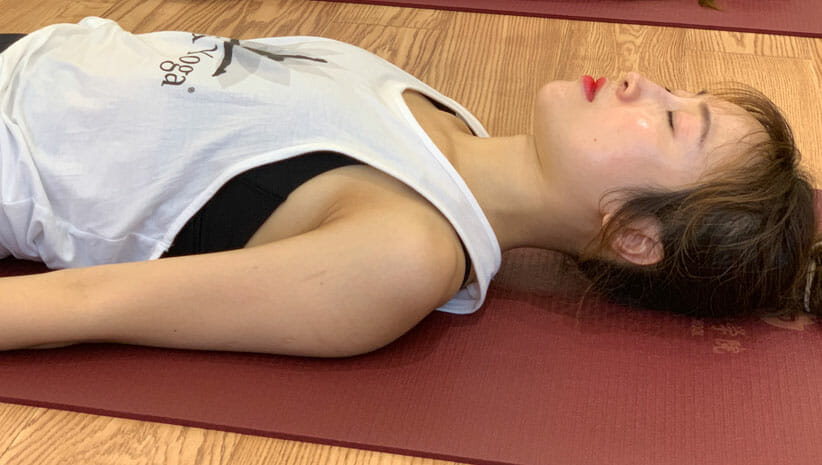
Savasana. Sense Withdrawal. Taking the Mind Inward.
It’s one of the most important poses in a yoga class and often one of the most misunderstood.
The Final Resting Pose.
My teacher, Sri Dharma Mittra, includes savasana in the category of the eight essential poses in yoga. Dharma is well known throughout the world for being a master teacher and having created the asana chart, which hangs on many studios’ walls, featuring Dharma in 908 asanas. According to Dharma, though, there are just eight essential poses. These are: head balance, shoulderstand, lotus pose, auspicious pose (siddhasana), cobra pose, seated forward fold, seated twist and the final resting pose (savasana).
How does the final resting pose make this list? What is this final resting pose all about and why is it so important?
I remember early on in my practice, being asked to lie down at the end of the class, and thinking the class was over. I wondered, “What are we doing now? What is this all about?” I remember being THAT student, who sits up in the middle of savasana, opens his eyes, and looks around the room, wondering if everyone else is still just lying there and trying to figure out if I was doing something wrong. Am I supposed to be DOING something right now? If so, WHAT am I supposed to be doing?
Savasana isn’t about staying awake and it isn’t about going to sleep either. The goal isn’t to take a short nap at the end of a hard physical practice. It’s also not to collect your thoughts and let your mind wander or go over the endless to-do list that we are constantly checking off in our minds.
Savasana is a pratyahara practice. Pratyahara means sense withdrawal. Think of this as the beginning of meditation. When you are in savasana, you are practicing letting go of your attachment to the body, the sense organs and the outside world. You are encouraging your mind to go inward. This happens when you go to sleep too. The difference between sleep and savasana (and also meditation) is that during savasana you are present during the experience. You are not present to your experience when you are sleeping. In savasana it’s like you are asleep but also awake.
The final resting pose is one of the most healing poses in yoga. When you go to sleep your body gets the chance to repair itself. Dharma says it is like taking the car to the mechanic. When you stay in the car the mechanic doesn’t do any work. You have to leave the car alone and come back and get it when it is ready. It’s the same with the body. When the mind is attached to the body, and the nervous system is active, and the sense organs are active and providing feedback, the body doesn’t repair itself. A tremendous amount of healing takes place when you leave the body alone.
Another teacher of mine, Srivatsa Ramaswami, says to think of your meditation as a test that lets you see how you are doing with the rest of your practice. It is the same with savasana. Think of it as a test at the end of your practice. Are you cultivating balance in your practice? When you arrive in savasana, having cultivated balance, you are able to let go of the body, the sense organs and your attachment to the outside world and let the mind turn inward quite easily. You’re able to leave the body by itself so that the mechanic can come and do the repairs.
The next time you are in class, take a moment after your savasana and observe your experience. If you were wide awake in your savasana, your mind fidgeting, your body unable to relax, aware of every sound in the room — then you needed to work harder in your practice leading up to savasana and you need to practice more concentration. If you drifted off and fell asleep in your savasana, didn’t stay present to your experience, maybe had to be woken up by the teacher because you were snoring, or missed the cue to come out — then you may have been working too hard during your practice leading up to savasana and you need to practice more relaxation.
You want to try to find balance in every pose. Concentrate and let the fire build, then practice surrendering into the fire and letting go. Find the balance between working hard enough to keep the mind focused and not working so hard that you become overwhelmed. If your body is fidgeting and your mind is wandering during your practice, you’re not working hard enough. Concentrate. Don’t let the mind wander.
If you catch yourself holding your breath, biting your lips, clenching your jaw, or squinting your eyes and you feel yourself getting frustrated or angry or overwhelmed, you’re working too hard. Relax. Breathe more deeply. Back off and slow down. Practice surrendering and softening. Try a less advanced variation of the pose you are doing or use a modification. Try to find the balance in every pose. Can you stay in the fire and also stay calm? Can you match the intensity with surrender? Keep thinking of your goal of preparing for a deep, relaxing and healing savasana at the end of your practice.
Tips for a Successful Savasana
Lie down. Separate your feet a little wider than hip distance. Let the toes fall out away from each other. Feel the legs completely relax. Rest your arms alongside your body, with the palms turned up. Let your shoulders relax. Keep the back of the neck long. Close your eyes. You can use a pillow under your head. You can cover your eyes with a towel. Place bolsters under your knees if you feel pain in your lower back.
